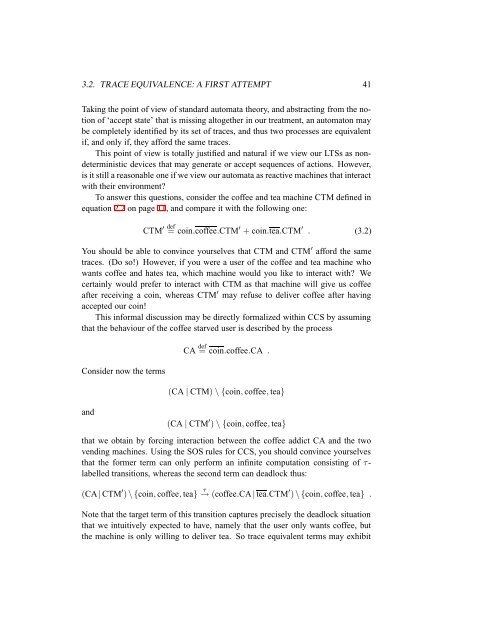Reactive Systems: Modelling, Specification and Verification - Cs.ioc.ee
Reactive Systems: Modelling, Specification and Verification - Cs.ioc.ee
Reactive Systems: Modelling, Specification and Verification - Cs.ioc.ee
Create successful ePaper yourself
Turn your PDF publications into a flip-book with our unique Google optimized e-Paper software.
3.2. TRACE EQUIVALENCE: A FIRST ATTEMPT 41<br />
Taking the point of view of st<strong>and</strong>ard automata theory, <strong>and</strong> abstracting from the notion<br />
of ‘accept state’ that is missing altogether in our treatment, an automaton may<br />
be completely identified by its set of traces, <strong>and</strong> thus two processes are equivalent<br />
if, <strong>and</strong> only if, they afford the same traces.<br />
This point of view is totally justified <strong>and</strong> natural if we view our LTSs as nondeterministic<br />
devices that may generate or accept sequences of actions. However,<br />
is it still a reasonable one if we view our automata as reactive machines that interact<br />
with their environment?<br />
To answer this questions, consider the coff<strong>ee</strong> <strong>and</strong> tea machine CTM defined in<br />
equation 2.2 on page 11, <strong>and</strong> compare it with the following one:<br />
CTM ′ def<br />
= coin.coff<strong>ee</strong>.CTM ′ + coin.tea.CTM ′ . (3.2)<br />
You should be able to convince yourselves that CTM <strong>and</strong> CTM ′ afford the same<br />
traces. (Do so!) However, if you were a user of the coff<strong>ee</strong> <strong>and</strong> tea machine who<br />
wants coff<strong>ee</strong> <strong>and</strong> hates tea, which machine would you like to interact with? We<br />
certainly would prefer to interact with CTM as that machine will give us coff<strong>ee</strong><br />
after receiving a coin, whereas CTM ′ may refuse to deliver coff<strong>ee</strong> after having<br />
accepted our coin!<br />
This informal discussion may be directly formalized within CCS by assuming<br />
that the behaviour of the coff<strong>ee</strong> starved user is described by the process<br />
Consider now the terms<br />
<strong>and</strong><br />
CA def<br />
= coin.coff<strong>ee</strong>.CA .<br />
(CA | CTM) \ {coin, coff<strong>ee</strong>, tea}<br />
(CA | CTM ′ ) \ {coin, coff<strong>ee</strong>, tea}<br />
that we obtain by forcing interaction betw<strong>ee</strong>n the coff<strong>ee</strong> addict CA <strong>and</strong> the two<br />
vending machines. Using the SOS rules for CCS, you should convince yourselves<br />
that the former term can only perform an infinite computation consisting of τlabelled<br />
transitions, whereas the second term can deadlock thus:<br />
(CA | CTM ′ ) \ {coin, coff<strong>ee</strong>, tea} τ → (coff<strong>ee</strong>.CA | tea.CTM ′ ) \ {coin, coff<strong>ee</strong>, tea} .<br />
Note that the target term of this transition captures precisely the deadlock situation<br />
that we intuitively expected to have, namely that the user only wants coff<strong>ee</strong>, but<br />
the machine is only willing to deliver tea. So trace equivalent terms may exhibit
















